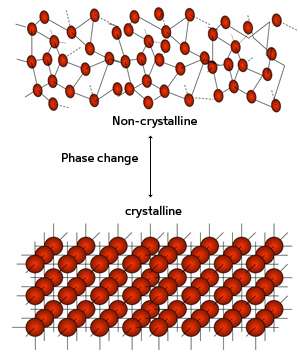Phase-change material with unexpected optical-reflectivity properties offers fresh perspectives for data storage

Memory is a central component of any computer or mobile device. Digital memories must not only store large amounts of data in a small space—and in a way that it is conveniently written, read and erased—but also meet ever-increasing demands on their size as well as their speed and energy efficiency. Phase-change materials, which switch their physical properties depending on whether they are in their crystalline or non-crystalline form, are being used to meet these requirements. A new kind of phase-change material with interesting features for memory applications—and with unexpected optical characteristics—has now been discovered by Wen Dong Song from the A*STAR Data Storage Institute and co-workers in Singapore.
Digital data requiring storage in a memory is generated in the form of ones and zeroes. This means that the storage material should be able to switch between two distinct states, one encoding '1' and the other '0'. This is typically accomplished by altering either magnetic properties, or, as is the case for phase-change materials, optical or electrical behavior.
Song and his co-workers found that materials made of the chemical elements iron and tellurium can change their property known as optical reflectivity depending on their crystalline state (see image). They demonstrated that the change between the crystalline and the non-crystalline form—and therefore between high and low reflectivity—can be induced simply and reversibly by heating the material, for example, by using a laser pulse. This switchable reflectivity provides a practical way for managing data in a small area. Moreover, the researchers showed that the change between the non-crystalline and crystalline phases can happen extremely fast, within tens of nanoseconds.
"Also, by altering the relative amount of iron and tellurium in the material, the temperature at which the phase change happens can be tuned and therefore adjusted for specific applications," says Song.
Other researchers have observed related behaviors in other phase-change materials, but Song and his team observed properties that are unique to their system. "To our surprise we found that in its non-crystalline state our material has a higher reflectivity than in its crystalline state," says Song. Normally, the opposite is true. "We [also] found that our material exhibits not only anomalous optical behavior, but also has anomalous electrical properties," Song explains. "These unique characteristics may lead to novel applications in data storage, such as new optical media and solid-state memories." He says that they will explore these anomalies further.
More information: Fu, X. et al. Anomalous phase change characteristics in Fe–Te materials. Applied Physics Letters 100, 201906 (2012). apl.aip.org/resource/1/applab/v100/i20/p201906_s1
Journal information: Applied Physics Letters




















